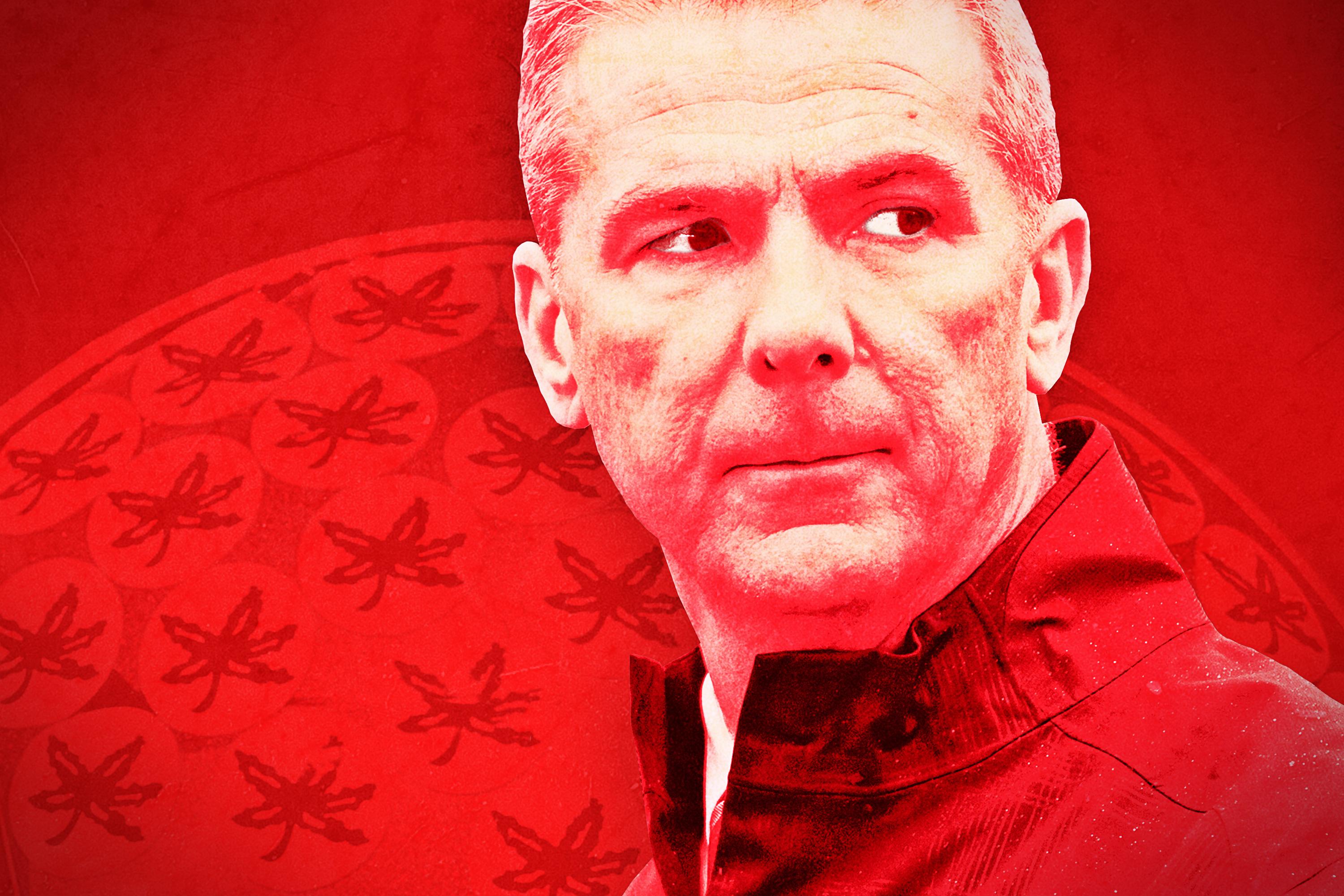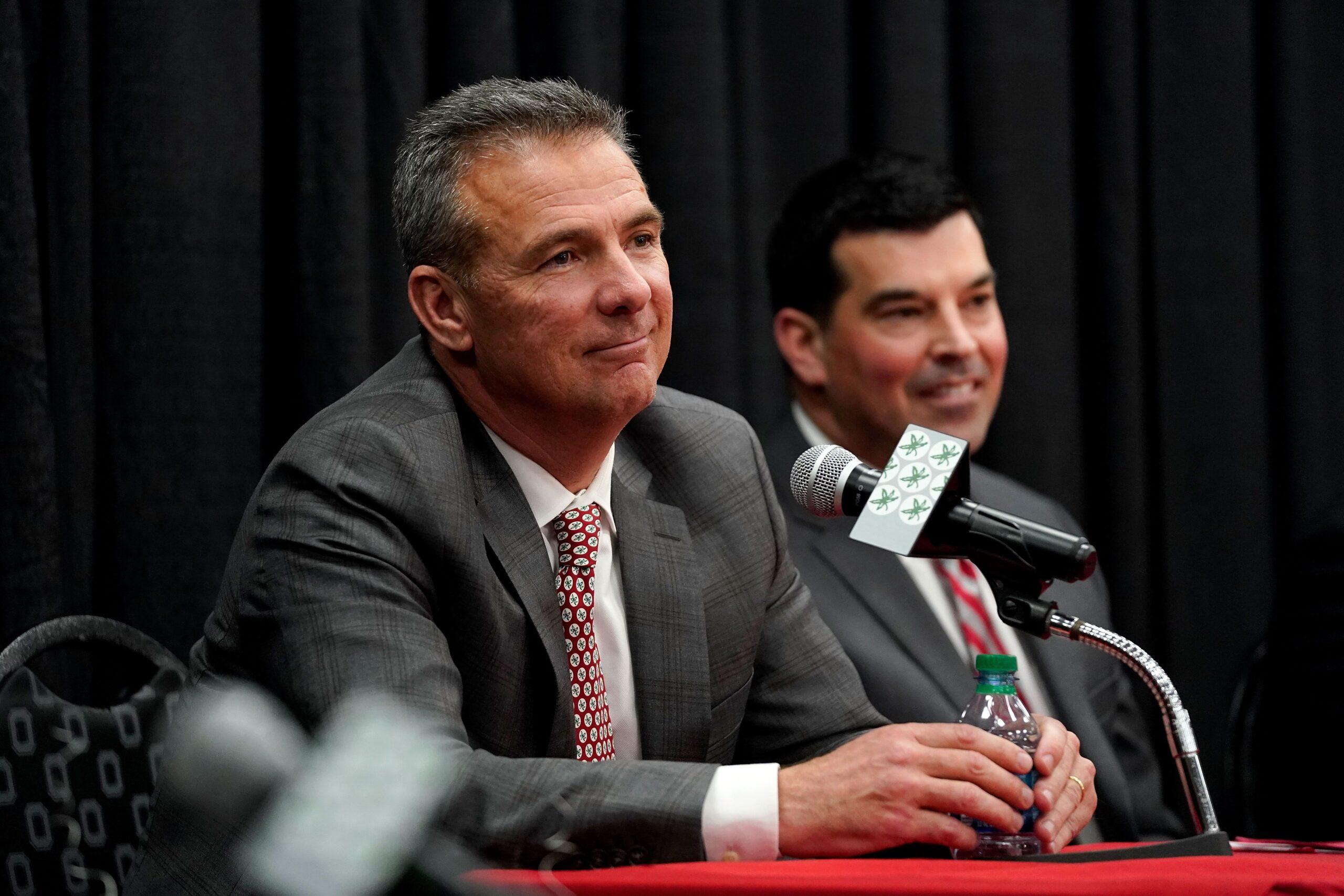Ohio State Stood By Urban Meyer So He Could Walk Away
In August, the university suspended Meyer for mishandling accounts of domestic abuse involving a longtime staffer. That decision was disappointing at the time—and may now be even more puzzling in retrospect.
In the end, there was no benefit to Ohio State’s August decision to retain Urban Meyer as head football coach after the world found out that he was willing to protect an assistant who had been named in multiple accounts of domestic violence. On Tuesday, Meyer announced that he would retire after January’s Rose Bowl matchup against Washington, a decision that is equal parts shocking and expected. He said the choice was “the result of cumulative events,” the biggest of which was his ongoing health issues. Now, just like that, the school finds itself in roughly the same position that it would’ve been in had it chosen to get rid of Meyer over the summer.
The school’s new head coach will be 39-year-old Ryan Day — the same man tapped to be the Buckeyes’ interim head coach when Meyer was suspended for the first three games of this season. Ohio State could’ve fired Meyer in August and still promoted Day to be the program’s next permanent coach. The team looked virtually the same in those games as the 10 coached by Meyer. Ohio State’s season played out in almost identical fashion to its 2017 campaign: It rolled to a blowout victory over Michigan, captured a Big Ten championship, and lost an inexplicably lopsided contest to an inferior conference opponent that kept the team out of the College Football Playoff. The university’s Board of Trustees met for nearly 11 hours on August 22 before reaching its decision to merely suspend Meyer. It knew how bad it’d look if it kept him, and only got to keep him for 11 more games.
One might ask: Was it worth it? Was it worth it for Ohio State to staunchly support a man who didn’t take action when informed of multiple accounts of abuse involving an employee? Was it worth it for Ohio State to jeopardize its reputation to protect a man who would soon quit?
The answer is no. Ohio State officials, like those at so many other schools, stuck their necks out to protect the supposed Great Leader of Men who was the coach of their program’s football team. Fans will sometimes argue that the wins are worth it; pragmatists will sometimes argue that the money generated by having a coach who wins is worth it. But in this case neither of those things is accurate. Ohio State’s football and financial results aren’t significantly better now than they would have been if the powers that be had simply fired Meyer a few months ago. Of course, keeping Meyer wouldn’t have been worth it if Ohio State had won the damn national championship. It is never worth it to do what is good for a football team over what is right. But as it turns out, that wasn’t the whole calculus here.
By retaining Meyer this offseason, Ohio State wasn’t prioritizing football success in 2018. It was prioritizing what it wants the narrative about the past few years to become, and it was giving the people currently in power the opportunity to preserve it.
Meyer has abruptly resigned before, in 2010, when he walked away from a Florida program he led to two national championships. Back then, Meyer cited a heart scare that sent him to the hospital and his desire to take the stress of coaching out of his life; with this resignation, Meyer is citing a congenital arachnoid cyst in his brain that “has led to severe headaches at times in his career.” Some have said that Meyer used medical issues as an excuse to leave both jobs at convenient times, but I don’t think that’s fair. When Meyer was doubled over in pain during games this season, he didn’t seem like a man who was faking it to give himself an easy out.
Similarly, Meyer’s mishandling of former Ohio State receivers coach Zach Smith has been equated with Meyer’s generally lenient stance toward player wrongdoing at Florida. This, too, is a mistake. As I wrote in August, most of the things Meyer’s Gators players did were typical college-student idiocy: smoking weed and getting in drunken fights. The few serious incidents were met with suspensions or expulsions.
This is completely different than Meyer repeatedly protecting his protegé and family friend Smith, who is the grandson of Meyer’s mentor, Earle Bruce. Meyer continued to employ Smith as an assistant coach even as the stories about Smith and domestic violence piled up. At Big Ten media days in July, Meyer told reporters that he’d lacked prior knowledge of a 2015 incident in which Courtney Smith, Zach Smith’s ex-wife, said that Zach pushed her against a wall and wrapped his hands around her neck while their then-3-year-old daughter clung to her leg. The school’s investigation later found this to be dishonest, even if it tried to pin it on Meyer having “significant memory issues in other situations where he had prior extensive knowledge of events.” Ohio State held that Meyer didn’t “deliberately lie.”
I believe that Meyer was deliberately lying. There is plenty of reporting that shows Meyer knew about the Smith incidents as they happened. I don’t believe that Meyer forgot everything bad his longtime assistant had done at the most convenient moment. I believe that Ohio State should have fired Meyer for protecting Smith. Instead, the school doubled down on Meyer.
Meyer is one of the winningest head coaches in college football history. He has gone 186–32 with three national titles over his Division I career, including 82–9 with one national championship in his Ohio State tenure. Perhaps of greatest importance to the Buckeyes fan base, he has never lost to rival Michigan. Yet it’s oversimplifying things to conclude that the university kept Meyer this summer because he was a winning coach. In fact, at an afternoon press conference in Columbus, Meyer admitted as much.
On Tuesday, power was smoothly transferred from one Ohio State employee to another Ohio State employee while a third Ohio State employee, athletic director Gene Smith, talked about overseeing that transition of power. Meyer revealed that he had been contemplating retirement since last season, and had been discussing the plan for his exit with Smith for more than a month. When asked about this, Meyer offered the following: “There was conversation before this year. Ryan [Day], like I told you, last January had a chance to become a head football coach at a pretty impressive place. I met with Gene, and you know, and I knew this isn’t something I’m gonna do for the next 15 years, 10 years. I knew after the experiences I had on the sideline again and in 2014 just dealing with headaches that I wanted to do Ohio State right, and Gene Smith right. So I would’ve probably thought not this year but it was within the next few.”

Ohio State wasn’t trying to buy a long-term future with Meyer when it chose to keep him around. He didn’t even plan to stay for more than a few years, and people at the school knew that. Meyer was retained to eventually ease the transition to the man who would become his successor.
Everyone involved with this arrangement is satisfied. Meyer gets to retire instead of getting fired in disgrace. Smith, who hired Meyer, does not have the stain of hiring somebody who turned out to be a disgrace. (If coaches get fired, athletic directors tend to get fired with them.) And the Buckeyes’ new head coach, Day, gets to serve as a continuation of Meyer’s legacy and Smith’s decision to hire Meyer. Ohio State can say that it moved from the glorious Meyer era — in which the Buckeyes went a sparkling 54–4 in Big Ten play — into an era led by a Meyer disciple.
But Ohio State doesn’t need a clean transition of power. Just seven years ago, the Buckeyes experienced just about the roughest coaching change imaginable. After parting ways with Jim Tressel over TattooGate, the school had a rare losing season under interim coach Luke Fickell. And guess what. Ohio State rode Cardale Jones, Ezekiel Elliott, and Joey Bosa to a national title three years later. Ohio State is a football powerhouse, and will remain one regardless of whether a coaching transition is sloppy.
If Ohio State had retained Meyer in August because the school considered on-field wins more valuable than a clean conscience, that would have been shameful enough. But I think that undersells what happened. The power structures in college football are designed by powerful men, and have long served to protect powerful men. In this case, they protected Meyer for protecting another man, all as part of a larger effort to protect even more powerful men.
Ohio State didn’t keep Meyer around for a bunch of national championship celebrations. It kept him around for today: a quiet departure that lets the machine around him keep humming.